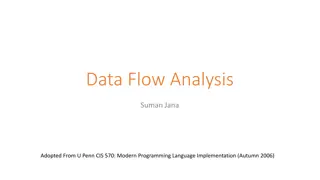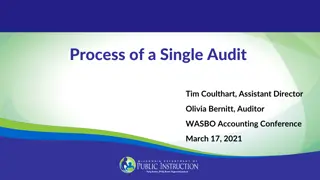Understanding Fund Flow Analysis in Business
Fund flow analysis in business involves examining the movement of working capital to understand changes in financial position over time. It focuses on the sources of funds and their uses, highlighting inflows, outflows, and overall changes in the company's financial health. By analyzing fund flow statements, businesses can make informed decisions to manage their finances effectively.
Download Presentation

Please find below an Image/Link to download the presentation.
The content on the website is provided AS IS for your information and personal use only. It may not be sold, licensed, or shared on other websites without obtaining consent from the author. Download presentation by click this link. If you encounter any issues during the download, it is possible that the publisher has removed the file from their server.
E N D
Presentation Transcript
MEANING OF FUND: The term fund is generally used to mean the difference between current assets and current liabilities. In other words, the term fund stands for net working capital or net current assets. Current assets include assets which are acquired with the intention of converting them into cash during the normal business operations of the company. They are: Cash in hand Cash at Bank Temporary or marketable investments Trade Debtors Bills receivables Short term loans Stock of Raw Material, Semi-finished goods, Finished goods, W-I-P etc. Prepaid expenses Accrued Incomes.
Current liabilities: The term current liabilities are used to describe such obligations which are paid within one year and which are paid out of current assets or by creating current liabilities. They are: Trade Creditors Bills payable Bank OD Outstanding expenses Dividend payable Provision against current assets Taxation provision Income received in advance
MEANING OF FLOW OF FUNDS The term flow means change and therefore the term flow of funds means change in Funds or change in working capital. In other words, any increase / decrease in working capital means flow of funds. In business several transactions take place. Some of these increase the funds while others decrease the funds. Some may not make any change in the funds position. The movement of funds may be inflow or outflow. It is said there is: Inflow of fund -When the business transaction results in increase in working capital. Outflow of fund When the business transaction results in decrease in working capital. No flow fund -When the business transaction results in neither increase nor decrease in working capital. It can be said that only the following transactions may cause the flow of fund. Transaction between One current asset & another noncurrent asset. One non-current liability & another current liability. One current liability & another noncurrent asset. One current asset & another noncurrent liability.
FUND FLOW STATEMENT A funds flow statement is a statement depicting change in working capital. According to Smith and Brown A funds flow statement is prepared in summary form to indicate the changes occurring in terms of financial condition between two different balance sheet dates . In the words of Robert Anthony The funds flow statements describe the sources from which additional funds were derived and the uses to which these funds were put . Hence funds flow statement is the most useful statement prepared to indicate the changes in the financial position of a business concern between the opening and closing balance sheet dates. It is the financial operational statement which reveals the methods by which a company has been financed. In other words it is a financial report on the movement of funds (working capital) stating sources from which funds generate and to which these funds are put into.
USES OF FUND FLOW STATEMENT Emerging as a supplemental financial statement, the funds flow statement has become an integral part of final accounts. It is a tool of decision-making, of analysis and of forecasting. Tools of Analysis: The funds flow statement analyses and explains the financial consequences of trading operations. It shows how the funds were obtained in the past and used. The financial manager can take corrective actions. Tool of working capital management: This statement reveals the adequacy or otherwise of working capital and the efficiency with which it is utilised. It enables management to take steps to put surplus working capital to effective use and also to augment the same in case it is insufficient. Tools of Decision making: The statement keeps management with regard to such decisions as dividends, capital expenditure and Budgetary control. Tool of forecasting: Financial resources of an enterprise are relatively scarce in relation to demand. A projected funds flow statement enables management not merely to utilize the available funds to the optimum extent, but also to prevent funds being allowed to flow in unprofitable channels. Tools of measuring credit worthiness: It also keeps the creditors and financial institutions to assess the risk factors involved in granting credit to a business concern. Shareholders and prospective investors are also enables to make an assessment of funds available for payment of dividend and the probable return on their future investment. The statement compared with the budget concerned will show to what extent the resources of the firm were used according to plan and what extent the utilisation was unplanned.
LIMITATIONS It lacks originality because it is only rearrangement of data appearing in financial statements. It is prepared taking into consideration only fund items and non-fund items are ignored. As such it is incomplete and unscientific. It reveals some additional information about changes in working capital. As such, it must be remembered that funds flow statement is not a substitute of the position Statement or income statement. The information used for the preparation of the fund flow statement is essentially historical in nature. So it is not of much use. It cannot reveal continuous changes. SOURCES OF FUNDS Issue of shares for Cash or for any other current asset. Issue of Debentures for cash or for any current asset. Long term / Medium Term Loans borrowed: Loans borrowed for purchase of fixed assets or for repayment of existing loan do not form the source of funds.
Long term, Medium Term Deposits accepted. Sale of Fixed Assets. Sale of long-term Investments for cash. Refund of Income Tax received. Funds from operations (operating or trading profit) Non-operating Incomes: Dividend received on Investments, Interest received on Investments, rent received, gifts received, donations received etc. are included under this head. USES OR APPLICATION OF FUNDS Funds lost in operation / Trading Loss: The loss suffered by a business in the normal & regular business operations is called operating loss. Redemption of preference shares in cash or in any other current assets. Redemption Debentures in cash.
Repayment of long terms loans in cash. e. Purchase of long term Investments. Purchase of fixed assets for cash. Non-operating expenses- This includes dividend paid on shares, Income tax paid, Donation given, fines paid etc.

















































